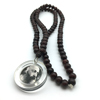Hidden Figures

Madhuri reviews a film that came out in January this year; the story of a team of female African-American mathematicians who served a vital role in NASA during the early years of the US space program.
That day in 1969, when two men walked on the moon, I was a teenager, sitting in a restaurant in San Jose, California; an Italian place with a red-checked tablecloth. There was a black-and-white television propped up for everyone to look at. Grey shadowy figures loomed and bobbed on a desert landscape. It was one of those moments you never forget – and, unusually, it was a collective memory which is beautiful. For the trip to the moon was foolhardy, romantic, purposeless – in a word, poetic. The scientists and the dreamers got together that day.
What I certainly did not know – what nobody was told – what the public had no way to discover – was that the enormous mathematical task involved, in those pre-computer days, for this as well as other space missions, was done in large part by a basement-ful of black female mathematical geniuses. They were also called ‘computers’.
…And, of course, these brilliant women had to use segregated toilets.
In those days, the public would not have been able to fathom the notion that people such as this could do this work – for they were not only black, but female! – for it was believed (just as in the previous century the British had believed the Irish were of inferior mental ability and gross and venal in every way – scarcely human) that a lot of melanin in your skin meant that your brain did not work very well. Having breasts was supposed to confer a similar limitation.
Thank god we are growing out of this idiocy (are we?).
I found this film incredibly moving – but not only that; it has been working in me ever since I saw it, weeks ago, and has been inspiring and empowering in ways I could never have expected: I ended up writing a story with female astronauts in it – as if I needed to take those underground ladies and let them not just thrive but fly.
The film follows the careers of three of these women, Katharine Johnson (Taraji P. Henson), Dorothy Vaughan (Octavia Spencer), and Mary Jackson (Janelle Monae), as they face racist bitchiness from white female colleagues, thwarted ambitions, segregated coffee urns, and toilets so far away they have to run for 20 minutes to get to them. Yet their work is relied upon and needed. One of them, Katherine, ends up working in the main ‘war room’, where the missions are guided from. There is a fair and beleaguered boss, Kevin Costner, he of the oh-so-reassuring profile. There is a faithful suitor for Katherine – they ended marrying and staying that way. There is juicy dancing and fun in the families of the women. There are ambitions finally realized.
It is a heartening movie, an inspiring movie – well made, no cheap thrills like violence – unless you count Kevin Costner taking a crowbar to the ‘Colored’ sign outside the toilet. There is a young John Glenn being a hero on the ground and in the air.
But most of all, there are these lively, sassy, incredibly bright women – treated like dirt, needed yet sequestered – when they can do something you and I have no hope of ever imagining being able to do.
I loved this film. It gets under your skin. There is the warm breath of the South in it, and the bright cutting-edge of a time in history when scientific intellect rewarded us with an unlikely adventure. Good mixture.
2 hrs 7 minutes. 2016. Directed by Theodore Melfi.
Winner of 6 awards, including Screen Actors Guild Award for Outstanding Performance by Cast in a Motion Picture, and two NAACP awards.
Review by Madhuri – www.madhurijewel.com
- Log in to post comments
- 17 views
